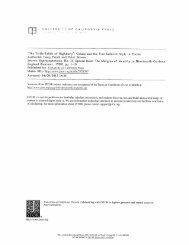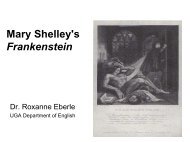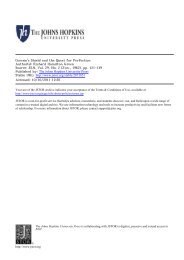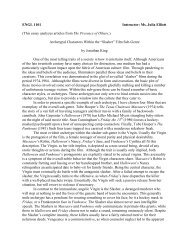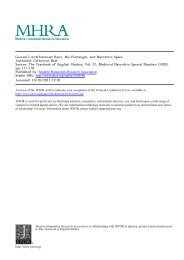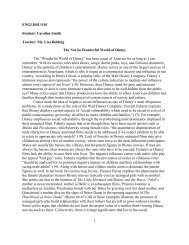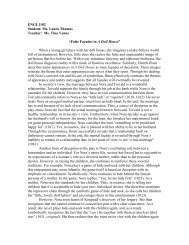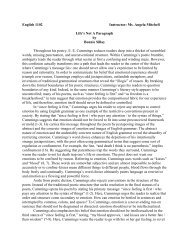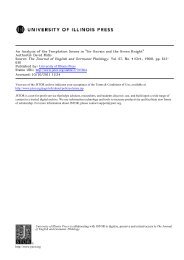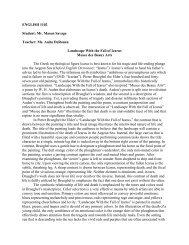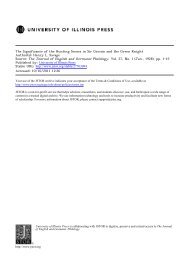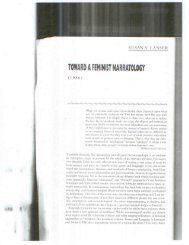Structure and Symmetry in Sir Gawain
Structure and Symmetry in Sir Gawain
Structure and Symmetry in Sir Gawain
Create successful ePaper yourself
Turn your PDF publications into a flip-book with our unique Google optimized e-Paper software.
Medieval Academy of America<br />
<strong>Structure</strong> <strong>and</strong> <strong>Symmetry</strong> <strong>in</strong> <strong>Sir</strong> Gawa<strong>in</strong><br />
Author(s): Donald R. Howard<br />
Source: Speculum, Vol. 39, No. 3 (Jul., 1964), pp. 425-433<br />
Published by: Medieval Academy of America<br />
Stable URL: http://www.jstor.org/stable/2852497 .<br />
Accessed: 10/10/2011 12:27<br />
Your use of the JSTOR archive <strong>in</strong>dicates your acceptance of the Terms & Conditions of Use, available at .<br />
http://www.jstor.org/page/<strong>in</strong>fo/about/policies/terms.jsp<br />
JSTOR is a not-for-profit service that helps scholars, researchers, <strong>and</strong> students discover, use, <strong>and</strong> build upon a wide range of<br />
content <strong>in</strong> a trusted digital archive. We use <strong>in</strong>formation technology <strong>and</strong> tools to <strong>in</strong>crease productivity <strong>and</strong> facilitate new forms<br />
of scholarship. For more <strong>in</strong>formation about JSTOR, please contact support@jstor.org.<br />
http://www.jstor.org<br />
Medieval Academy of America is collaborat<strong>in</strong>g with JSTOR to digitize, preserve <strong>and</strong> extend access to<br />
Speculum.
STRUCTURE AND SYMMETRY IN SIR GAWAIN<br />
By DONALD R. HOWARD<br />
No one who reads <strong>Sir</strong> Gawa<strong>in</strong> <strong>and</strong> the Green Knight fails to notice its elaborate,<br />
symmetrical structure. Everywhere <strong>in</strong> the poem is balance, contrast, <strong>and</strong> antith-<br />
esis. Th<strong>in</strong>gs are arranged <strong>in</strong> pairs - there are two New Year's days, two "be-<br />
head<strong>in</strong>g" scenes, two courts, two confessions; or <strong>in</strong> threes - three temptations,<br />
three hunts, three kisses, three strokes of the ax. These <strong>in</strong>tricacies are unobtru-<br />
sively <strong>in</strong>tegrated with events <strong>and</strong> themes; <strong>and</strong> perhaps just for that reason,<br />
critics have taken note of them only piecemeal <strong>and</strong> <strong>in</strong> pass<strong>in</strong>g, often with refer-<br />
ence to the poem's mythic or symbolic content.l In what follows I <strong>in</strong>tend to ex-<br />
am<strong>in</strong>e the narrative units based upon structural parallels <strong>in</strong> <strong>Sir</strong> Gawa<strong>in</strong>, <strong>and</strong> to<br />
suggest <strong>in</strong> what way they co<strong>in</strong>cide with the divisions of the poem marked by the<br />
ornamented <strong>and</strong> colored capitals of the manuscript. To do so, however, I shall<br />
have to turn first to the symbolism of the poem; for what I wish to argue is that<br />
its most protracted structural parallel depends upon the juxtaposition of two<br />
symbols, the shield <strong>and</strong> the girdle.<br />
I.<br />
Everyone from Mary McCarthy to C. S. Lewis has expressed caveats about<br />
literary symbolism, <strong>and</strong> it is true, symbol-hunt<strong>in</strong>g is an easy game with no par-<br />
ticular criteria of corrigibility. In the study of mediaeval literature there is the<br />
added problem of a vast body of symbolism based on the four-level method of<br />
<strong>in</strong>terpret<strong>in</strong>g Scripture.2 It is reassur<strong>in</strong>g, therefore, to have at least one mediaeval<br />
work <strong>in</strong> which the symbols are identified as such by the author. No one has ever<br />
questioned the fact that the pentangle shield <strong>and</strong> the green girdle <strong>in</strong> <strong>Sir</strong> Gawa<strong>in</strong><br />
<strong>and</strong> the Green Knight are symbols. They are neither "Freudian" nor "patristic."<br />
Rather, the author tells us <strong>in</strong> 11. 619-665 what the pentangle means, <strong>and</strong> there is<br />
precedent <strong>in</strong> mediaeval lore for that symbolic mean<strong>in</strong>g. Likewise with the magic<br />
girdle, when Gawa<strong>in</strong> keeps it at the end of the poem he says <strong>in</strong> so many words<br />
that it is to be a "syngne of my surfet" to rem<strong>in</strong>d him of the "faut <strong>and</strong> pe fayntyse<br />
of pe flesche crabbed."3<br />
Yet I th<strong>in</strong>k no one has exam<strong>in</strong>ed the way <strong>in</strong> which these two symbols are juxta-<br />
posed <strong>and</strong> paired, so that their mean<strong>in</strong>g, to use Northrop Frye's language, comes<br />
1 Morton W. Bloomfield <strong>in</strong> "<strong>Sir</strong> Gawa<strong>in</strong> <strong>and</strong> the Green Knight: An Appraisal," (PMLA, LXXVI<br />
[1961], 17) has po<strong>in</strong>ted to the need for detailed analysis of the poem's structure. Some pert<strong>in</strong>ent<br />
comments may be found <strong>in</strong> Charles Moorman, "Myth <strong>and</strong> Mediaeval Literature: <strong>Sir</strong> Gawa<strong>in</strong> <strong>and</strong><br />
the Green Knight," Mediaeval Studies, xvIIi (1956), 164-169, <strong>and</strong> <strong>in</strong> Francis Berry, "<strong>Sir</strong> Gawayne<br />
<strong>and</strong> the Grene Knight," <strong>in</strong> The Age of Chaucer, ed. Boris Ford (Pelican Books A290, 1954), pp. 152-155.<br />
For further references see the footnotes which follow.<br />
2 With respect to <strong>Sir</strong> Gawa<strong>in</strong>, see Hans Schnyder, <strong>Sir</strong> Gawa<strong>in</strong> <strong>and</strong> the Green Knight: An Essay <strong>in</strong><br />
Interpretation, Cooper Monographs, 6 (Bern, 1961). While Schnyder grants (p. 74) that "the poem<br />
does not simply consist of a series of allegorical situations pedantically <strong>and</strong> pa<strong>in</strong>stak<strong>in</strong>gly strung<br />
together," he treats dozens of recondite symbols <strong>in</strong> the poem without ever acknowledg<strong>in</strong>g the<br />
humorous tone, <strong>and</strong> devotes a chapter to the temptations without ever mention<strong>in</strong>g the girdle.<br />
811. 2433-36. References are to the edition of J. R. R. Tolkien <strong>and</strong> E. V. Gordon (Oxford, 1930).<br />
425
426<br />
<strong>Structure</strong> <strong>and</strong> <strong>Symmetry</strong> <strong>in</strong> <strong>Sir</strong> Gawa<strong>in</strong><br />
about through the centripetal force of their relationship with<strong>in</strong> the whole literary<br />
structure.4 Gawa<strong>in</strong>'s journey to the Green Chapel, we know, is made <strong>in</strong> two stages.<br />
Hence there are two descriptions of the arm<strong>in</strong>g of the knight, one when he leaves<br />
Arthur's court (11. 536-669), the other when he leaves Bercilak's castle (11. 2011-<br />
41). The earlier passage beg<strong>in</strong>s with Gawa<strong>in</strong>'s statement of his <strong>in</strong>difference to his<br />
dest<strong>in</strong>y - "Quat schuld I wonde?/ Of dest<strong>in</strong>es derf <strong>and</strong> dere / What may mon do<br />
bot fonde?" (11. 563-565); it ends with the description of the shield. The later<br />
passage, however, ends with a description not of the shield but of the girdle,<br />
which Gawa<strong>in</strong> wears "to save himself."<br />
Thus the girdle, with<strong>in</strong> the symbolic structure of the poem, becomes a substitute<br />
for the shield. By shield I mean the shield itself, not its pa<strong>in</strong>ted allegory.<br />
Critics often treat the shield <strong>and</strong> its pentangle device as a s<strong>in</strong>gle object, which of<br />
course they are. Yet the symbolism of shield <strong>and</strong> girdle is symbolism of a different<br />
k<strong>in</strong>d from that of the pentangle. The pentangle has an assigned symbolic value; it<br />
is put <strong>in</strong>to the poem <strong>in</strong> order to st<strong>and</strong> for an abstraction, like Sansfoy <strong>and</strong> Sansloy,<br />
or S<strong>in</strong> <strong>and</strong> Death. It tells us that Gawa<strong>in</strong> is the "pentagonal man," the ideal<br />
knight.5 The shield <strong>and</strong> girdle, however, take their symbolic mean<strong>in</strong>g from the<br />
situation, the use they are put to, the attitudes <strong>and</strong> emotions which people show<br />
towards them, <strong>and</strong> their juxtaposition one aga<strong>in</strong>st the other. They rema<strong>in</strong> just as<br />
much girdle <strong>and</strong> shield as Desdemona's h<strong>and</strong>kerchief rema<strong>in</strong>s a h<strong>and</strong>kerchief, or<br />
Eve's apple an apple. While the pentangle is a pa<strong>in</strong>ted sign-it appears on the<br />
knight's cote-armor as well as on his shield6 - the shield <strong>and</strong> girdle are real objects,<br />
<strong>and</strong> function <strong>in</strong> the poem as liv<strong>in</strong>g, articulate symbols, dynamically paired.<br />
The pentangle shield of course evokes the chivalric ideal. As part of the knight's<br />
armor, it is not surpris<strong>in</strong>g that it has symbolic mean<strong>in</strong>g, for a knight's garments<br />
<strong>and</strong> gear, like a priest's vestments, were often given symbolic values.7 Yet the<br />
description of the arm<strong>in</strong>g of <strong>Sir</strong> Gawa<strong>in</strong> gives no symbolic mean<strong>in</strong>g to anyth<strong>in</strong>g<br />
but the pentangle. All his articles of cloth<strong>in</strong>g <strong>and</strong> armor are described <strong>in</strong> the most<br />
worldly terms -<br />
they are of costly silk, of bright fur, of well-worked <strong>and</strong> highly<br />
polished steel adorned with gold. His helmet, the last garment he puts on (kiss<strong>in</strong>g<br />
it as a priest might kiss the stole), has a silk cover embroidered with the best gems<br />
<strong>and</strong> encircled with costly diamonds. His garments <strong>and</strong> armor are also useful -<br />
4 See Anatomy of Criticism (Pr<strong>in</strong>ceton, 1957), pp. 82-94. That the shield <strong>and</strong> girdle st<strong>and</strong> <strong>in</strong> rela-<br />
tion to each other is recognized by Robert W. Ackerman, "Gawa<strong>in</strong>'s Shield: Penitential Doctr<strong>in</strong>e <strong>in</strong><br />
Gawa<strong>in</strong> <strong>and</strong> the Green Knight," Anglia, LXXVI (1958), 265, <strong>and</strong> by Richard H. Green, "Gawa<strong>in</strong>'s<br />
Shield <strong>and</strong> the Quest for Perfection," ELH, xxix (1962), 137.<br />
6 On the pentangle, see V<strong>in</strong>cent F. Hopper, Medieval Number Symbolism ..., Columbia Univer-<br />
sity Studies <strong>in</strong> English <strong>and</strong> Comparative Literature, 132 (New York, 1938), pp. 124-125, <strong>and</strong><br />
Edgar de Bruyne, Etudes d'esthetique medievale, II: L'epoque romane, Rijksuniversiteit te Gent,<br />
Werken uitgegeven door de Faculteit van de Wijsbegeerte en Letteren, 98 (Bruges, 1946), pp. 349-<br />
350; also Green, pp. 129-135. On the shield, see Green, pp. 126-129 <strong>and</strong> Schnyder, pp. 53-54.<br />
6 See l<strong>in</strong>e 637.<br />
7 On the symbolism of the knight's garments, see Edgar Prestage, "The Chivalry of Portugal,"<br />
<strong>in</strong> Chivalry: A Series of Studies to Illustrate Its Historical Significance <strong>and</strong> Civiliz<strong>in</strong>g Influence, ed.<br />
Edgar Prestage (New York, 1928), p. 145; A. T. Byles, "Medieval Courtesy Books <strong>and</strong> the Prose<br />
Romances of Chivalry," ibid., p. 192; Sidney Pa<strong>in</strong>ter, French Chivalry: Chivalric Ideas <strong>and</strong> Prac-<br />
tices <strong>in</strong> Mediaeval France (Baltimore, 1940), pp. 83-84.
<strong>Structure</strong> <strong>and</strong> <strong>Symmetry</strong> <strong>in</strong> <strong>Sir</strong> Gawa<strong>in</strong> 427<br />
they are "alle pe godlych gere pat hym gayn schulde" (1. 584). The poet has con-<br />
centrated all his powers on the lush description <strong>and</strong> saved the symbolism of moral<br />
values until the end, where it is more po<strong>in</strong>ted <strong>and</strong> dramatic. By arrang<strong>in</strong>g his<br />
material <strong>in</strong> this way, he has underscored an essential fact: that a knight's valor is<br />
dependent on worldly means. The practice of chivalry presents the knight with<br />
the problem of us<strong>in</strong>g the world's goods for worldly ends <strong>and</strong> yet adopt<strong>in</strong>g those<br />
virtues which will keep him from lov<strong>in</strong>g the world itself.<br />
After hear<strong>in</strong>g Mass, Gawa<strong>in</strong> puts on his helmet <strong>and</strong> takes up the shield (the<br />
manuscript at this po<strong>in</strong>t makes a subdivision with a colored capital).8 On its<br />
<strong>in</strong>side is the image of the Blessed Virg<strong>in</strong>, which will rem<strong>in</strong>d Gawa<strong>in</strong> of her five<br />
joys <strong>and</strong> so renew his courage. On its outside is the pentangle or "endless knot,"<br />
represent<strong>in</strong>g Gawa<strong>in</strong>'s perfection <strong>in</strong> his five senses <strong>and</strong> his five f<strong>in</strong>gers, his faith <strong>in</strong><br />
the five wounds of Christ <strong>and</strong> the five joys of the Virg<strong>in</strong>, <strong>and</strong> his possession of the<br />
five knightly virtues - franchise, fellowship, purity, courtesy, <strong>and</strong> pity.9 (These<br />
virtues, as Professor Engelhardt has shown,10 correspond <strong>in</strong> a general way to the<br />
chivalric virtues of piety, valor, <strong>and</strong> courtesy, <strong>and</strong> so represent his religious, mili-<br />
tary, <strong>and</strong> courtly obligations.) Hence the shield, with its images on either side,<br />
functions <strong>in</strong> two ways - to the knight as a devotional rem<strong>in</strong>der, to the world as<br />
an emblem of his <strong>in</strong>ner moral perfection. It is at base a worldly object, a part of<br />
his warlike gear, designed at once to protect his body <strong>and</strong> rem<strong>in</strong>d him of his im-<br />
mortal soul, so that it suggests at once his knightly valor <strong>and</strong> his spiritual <strong>in</strong>dif-<br />
ference to dest<strong>in</strong>y. To the world, the shield shows what spiritual strength lies<br />
beneath Gawa<strong>in</strong>'s rich trapp<strong>in</strong>gs; to Gawa<strong>in</strong>, it shows what ultimate spiritual<br />
mean<strong>in</strong>g lies beneath the world's bright lures. Yet it is to have this devotional <strong>and</strong><br />
spiritual mean<strong>in</strong>g precisely <strong>in</strong> those moments when he is most the knight, when he<br />
is most given to worldly deeds <strong>and</strong> most reliant upon the shield as a made object.<br />
It thus po<strong>in</strong>ts to the proper attitude for a knight: to be <strong>in</strong>different to one's life <strong>in</strong><br />
the world <strong>and</strong> yet preserve it, to use the world well <strong>and</strong> yet love it little.11<br />
* * *<br />
After the temptations, when Gawa<strong>in</strong> is ready to leave the castle for the Green<br />
Chapel, the poet aga<strong>in</strong> describes the arm<strong>in</strong>g of the knight. This time, however, he<br />
says noth<strong>in</strong>g about the shield; <strong>in</strong>stead, he ends by expla<strong>in</strong><strong>in</strong>g why Gawa<strong>in</strong> wears<br />
the girdle:<br />
Bot wered not lis ilk wy3e for wele lis gordel,<br />
For pryde of ]e pendaunte3, ]a3 polyst Pay were,<br />
And ba3 ]e glyter<strong>and</strong>e golde glent vpon ende3,<br />
8 See Tolkien <strong>and</strong> Gordon, p. viii.<br />
9 Ackerman (Anglia, LXXVI, 254-265) suggests that the reference to the five wits would have<br />
called up fourteenth-century writ<strong>in</strong>gs on auricular confession, so that the passage is consistent with<br />
the later theme of penitence.<br />
10 George J. Engelhardt, "The Predicament of Gawa<strong>in</strong>," Modern Language Quarterly, xvi (1955),<br />
218-225.<br />
n On the Christian <strong>and</strong> "otherworldly" aspects of the chivalric code, see Pa<strong>in</strong>ter, Chap. 3, <strong>and</strong><br />
F. Warre Cornish, Chivalry (London, 1908), pp. 218-219. See also Henry Osborn Taylor, The Medi-<br />
aeval M<strong>in</strong>d: A History of the Development of Thought <strong>and</strong> Emotion <strong>in</strong> the Middle Ages, 2 vols. (London,<br />
1930), I, 545-551.
428<br />
<strong>Structure</strong> <strong>and</strong> <strong>Symmetry</strong> <strong>in</strong> <strong>Sir</strong> Gawa<strong>in</strong><br />
Bot for to sauen hymself, when suffer hym byhoued,<br />
To byde bale withoute dabate of bronde hym to were<br />
ober knyffe.<br />
(11. 2037-2042)<br />
As the shield is emblematic of Gawa<strong>in</strong>'s knightly virtue, the girdle is emblema-<br />
tic of his fault. The whole movement of the story hangs upon his yield<strong>in</strong>g to temp-<br />
tation, accept<strong>in</strong>g the girdle, <strong>and</strong> hav<strong>in</strong>g his fail<strong>in</strong>g revealed to him. In the end,<br />
Gawa<strong>in</strong> himself makes the girdle a symbol of his "surfet" <strong>and</strong> of the weakness of<br />
the flesh. Now a girdle was an ord<strong>in</strong>ary article of cloth<strong>in</strong>g, a belt or c<strong>in</strong>cture from<br />
which one hung objects like keys or a purse. Because of its function, it was a<br />
convenient symbol for worldl<strong>in</strong>ess - the Oxford English Dictionary <strong>in</strong> fact re-<br />
ports such a metaphorical usage <strong>in</strong> the fifteenth century. This girdle, however,<br />
has the added lure of be<strong>in</strong>g rich <strong>and</strong> f<strong>in</strong>ely wrought <strong>in</strong> its own right: it is made of<br />
green silk, embroidered about the edges, <strong>and</strong> hung with pendants of highly<br />
polished gold.12 More than that, it has powers of its own- not merely an em-<br />
blematic mean<strong>in</strong>g, like that of the shield's device, but remarkable "costes pat knit<br />
ar per<strong>in</strong>ne" (1. 1849), magical properties to save the wearer from be<strong>in</strong>g sla<strong>in</strong>. The<br />
author carefully rem<strong>in</strong>ds us that Gawa<strong>in</strong> accepts the girdle for these powers, not<br />
for its richness. He goes so far as to tell us what the knight thought before<br />
accept<strong>in</strong>g it:<br />
pen kest be kny3t, <strong>and</strong> hit come to his hert,<br />
Hit were a juel for be joparde bat hym iugged were,<br />
When he acheued to be chapel his chek for to fech;<br />
My3t he haf slypped to be vnslayn, be sle3t were<br />
noble. (11. 1855-58)<br />
And Gawa<strong>in</strong>, when he proposes to wear it as a memento of his fail<strong>in</strong>g, himself<br />
denies any <strong>in</strong>terest <strong>in</strong> either its worth or its beauty:<br />
'Bot your gordel' quo] Gawayn 'God yow for3elde!<br />
pat wyl I welde wyth good wylle, not for be wynne<br />
golde,<br />
Ne be saynt, ne be sylk, ne be syde pendaundes,<br />
For wele ne for worchyp, ne for be wlonk werkke3,<br />
Bot <strong>in</strong> syngne of my surfet I schal se hit ofte,<br />
When I ride <strong>in</strong> renoun, remorde to myseluen<br />
pe faut <strong>and</strong> be fayntyse of be flesche crabbed,<br />
How tender hit is to entyse teches of fyl]e...<br />
(11. 2429-36)<br />
Gawa<strong>in</strong> has taken the girdle, then, not to own it for its value or wear it for its<br />
beauty, but simply to save his life.13 It is as worldly an object, <strong>and</strong> used for as<br />
worldly an end as the shield; but unlike the shield, it is magical, it is used solely<br />
for a selfish reason, <strong>and</strong> its acceptance requires that he act dishonorably either to<br />
the lady or her husb<strong>and</strong> if he is to keep it. He is guilty not because he desires "to<br />
sauen hymself," but because <strong>in</strong> order to do so he uses worldly means <strong>in</strong> the wrong<br />
way.<br />
12 See 11. 1830-33, 2037-39, 2430-32.<br />
13 John Burrow <strong>in</strong> "The Two Confession Scenes <strong>in</strong> <strong>Sir</strong> Gawa<strong>in</strong> <strong>and</strong> the Green Knight" (Modern<br />
Philology, LVII [1959], 73-79) has po<strong>in</strong>ted out that Gawa<strong>in</strong> twice confesses to covetousness (11. 2374-<br />
86, 2507-08) but his extravagance is corrected <strong>and</strong> the s<strong>in</strong> specifically denied (1. 2366-68, 2429-32).
<strong>Structure</strong> <strong>and</strong> <strong>Symmetry</strong> <strong>in</strong> <strong>Sir</strong> Gawa<strong>in</strong><br />
Even after he has taken the girdle, however, the knight cont<strong>in</strong>ues to profess<br />
submission to God's will. When tempted by his guide to flee he declares, "Ful wel<br />
con dry3tyn schape / His seruaunte3 for to saue" (11. 2138-39), <strong>and</strong> aga<strong>in</strong>, "I wyl<br />
naujer grete ne grone; / To Godde3 wylle I am ful bayn, / And to hym I haf me<br />
tone" (11. 2157-59). So, when he sees the Green Chapel, he says, "Let God<br />
worche! .. . My lif pa3 I forgoo, / Drede dot3 me no lote" (11. 2208-11). In these<br />
utterances we must not th<strong>in</strong>k him hypocritical. While he has taken the girdle <strong>and</strong><br />
presumably held some hope for its efficacy, he has not deserted, but compromised,<br />
the chivalric ideal <strong>and</strong> its religious requirements. He is, <strong>in</strong> fact, never wholly sure<br />
of the girdle's powers. At the first stroke of the ax he fl<strong>in</strong>ches; <strong>and</strong> on the third<br />
stroke, when his neck is nicked, he bounds up <strong>and</strong> throws <strong>in</strong>to place - his shield.<br />
Gawa<strong>in</strong>'s <strong>in</strong>difference to "dest<strong>in</strong>es derf <strong>and</strong> dere" is, we need to remember, the<br />
self-abnegation not of the cloistered monk but of the active knight. "What may<br />
mon do bot fonde?" (1. 565) he had asked - what can one do but try. He is ad-<br />
mirably suited to put his dest<strong>in</strong>y to the test: he is devoted to the articles of faith<br />
<strong>and</strong> has the virtues appropriate to the ideal Christian knight. The problem is to<br />
ma<strong>in</strong>ta<strong>in</strong> the f<strong>in</strong>e balance between this religious ethos <strong>and</strong> the unavoidable neces-<br />
sity of us<strong>in</strong>g worldly means to preserve life <strong>and</strong> accomplish knightly deeds. Hence<br />
he accepts the girdle not for any active pride which revolts aga<strong>in</strong>st God, nor for<br />
avarice, nor covetousness, nor for va<strong>in</strong>glory, but for <strong>in</strong>st<strong>in</strong>ctive self-preservation,<br />
the central, <strong>in</strong>voluntary worldl<strong>in</strong>ess of fallen man, through which even the best is<br />
easily tempted. This perfectly underst<strong>and</strong>able weakness, however, leads him <strong>in</strong>to<br />
other transgressions - the break<strong>in</strong>g of his oath to the lord, the false confession,<br />
the last failure of courtesy to the Green Knight. Once he has upset that f<strong>in</strong>ely<br />
balanced <strong>in</strong>difference to the world, those of the chivalric virtues which govern<br />
worldly action become <strong>in</strong> part unatta<strong>in</strong>able. The poem suggests <strong>in</strong> this way how<br />
the worldly aims of chivalry <strong>and</strong> the other-worldly aims of the Christian life are<br />
ideally <strong>in</strong>terrelated, but, for fallen man, potentially <strong>in</strong>compatible.<br />
II.<br />
429<br />
The poet suggested these dist<strong>in</strong>ctions by treat<strong>in</strong>g as symbols articles which<br />
were naturally part of his story. The girdle <strong>and</strong> shield are juxtaposed as two k<strong>in</strong>ds<br />
of worldl<strong>in</strong>ess: the girdle an illicit <strong>and</strong> self-centered means of hold<strong>in</strong>g on to life;<br />
the shield an allowable, self-abnegat<strong>in</strong>g use of the world's goods <strong>in</strong> the service of<br />
the highest Christian ideals. These two symbols, paired so that they reflect the<br />
moral choice which confronts the hero, <strong>in</strong>itiate two sequences which form a major<br />
structural parallel <strong>in</strong> the poem. The ma<strong>in</strong> action, beg<strong>in</strong>n<strong>in</strong>g with Gawa<strong>in</strong>'s<br />
departure <strong>in</strong> the second division, falls <strong>in</strong>to two stages - the events at the castle,<br />
<strong>and</strong> those at the Green Chapel.14 The one comprises Sections II <strong>and</strong> III; the<br />
14 Dale B. J. R<strong>and</strong>all <strong>in</strong> "A Note on <strong>Structure</strong> <strong>in</strong> <strong>Sir</strong> Gawa<strong>in</strong> <strong>and</strong> the Green Knight" (Modern<br />
Language Notes, LxxII [1957], 161-163) po<strong>in</strong>ts out also that the Green Knight is the fiendish chal-<br />
lenger at the beg<strong>in</strong>n<strong>in</strong>g <strong>and</strong> end, but the genial host <strong>in</strong> the middle. The three parts correspond to<br />
those I have outl<strong>in</strong>ed - the "prologue," <strong>and</strong> the two parts of the major action. Such a triple struc-<br />
ture was po<strong>in</strong>ted out by Sylvan Barnet ("A Note on the <strong>Structure</strong> of <strong>Sir</strong> Gawa<strong>in</strong> <strong>and</strong> the Green<br />
Knight," MLN, LXXI [1956], 319), who remarks on its consistency with the pattern hunt-temptation-<br />
hunt, with the three temptations, three hunts, three strokes of the ax, <strong>and</strong> so on.
430<br />
<strong>Structure</strong> <strong>and</strong> <strong>Symmetry</strong> <strong>in</strong> <strong>Sir</strong> Gawa<strong>in</strong><br />
other, Section IV. No one, I th<strong>in</strong>k, has noticed that these two sequences are<br />
matched by an elaborate parallelism. The same k<strong>in</strong>ds bf events, <strong>in</strong> exactly the<br />
same order, occur <strong>in</strong> either part, <strong>and</strong> they center upon the'three temptations <strong>in</strong><br />
the first sequence <strong>and</strong> the three strokes of the ax <strong>in</strong> the second, with a confession<br />
follow<strong>in</strong>g <strong>in</strong> each. These parallel contrasts are used artistically to dist<strong>in</strong>guish<br />
Gawa<strong>in</strong>'s temptation <strong>and</strong> fall from his punishment <strong>and</strong> pardon. We shall see this<br />
best if we represent the contrasts <strong>in</strong> diagram:<br />
Sections II-III Section IV<br />
(1) Arm<strong>in</strong>g of the knight, <strong>and</strong> descrip- Arm<strong>in</strong>g of the knight, <strong>and</strong> description<br />
tion of the shield (11. 536-669)<br />
(2) Journey to the castle (11. 670-762)<br />
of the girdle (11. 1998-2041)<br />
Journey to the Green Chapel (11. 2069-<br />
2159)<br />
(3) Description of the castle (11. 763- Description of the Green Chapel (11.<br />
810) 2160-2211)<br />
(4) Three temptations (11. 1126-1869)<br />
(5) Confession to priest (11. 1876-1884)<br />
Three strokes of the ax (11. 2212-2330)<br />
Confession to Green Knight (11. 2378-<br />
2438)<br />
This structural design co<strong>in</strong>cides with the four manuscript divisions marked by<br />
ornamented capitals, the four "sections" of the poem observed <strong>in</strong> editions. Now<br />
the last three of these are subdivided by small ornamented capitals, so that the<br />
whole falls <strong>in</strong>to n<strong>in</strong>e units.15 These n<strong>in</strong>e units seem to be based on a pr<strong>in</strong>ciple of<br />
suspense; they mark off blocks of <strong>in</strong>formation. The four major divisions, on the<br />
other h<strong>and</strong>, mark the major episodes of the story - the open<strong>in</strong>g scene, with the<br />
behead<strong>in</strong>g episode <strong>and</strong> challenge; the pass<strong>in</strong>g of a year, <strong>and</strong> Gawa<strong>in</strong>'s journey to<br />
the castle; the temptations; <strong>and</strong> the second "behead<strong>in</strong>g" scene, followed by the<br />
explanation <strong>and</strong> Gawa<strong>in</strong>'s return to court. The open<strong>in</strong>g scene is kept as a s<strong>in</strong>gle<br />
unit with no <strong>in</strong>ternal division - a k<strong>in</strong>d of prologue to the mission which Gawa<strong>in</strong><br />
must undertake. The work beg<strong>in</strong>s <strong>and</strong> ends with a reference to the fall of Troy<br />
<strong>and</strong> the found<strong>in</strong>g of Brita<strong>in</strong>, so that the events at Arthur's court are seen <strong>in</strong> the<br />
perspective of history as a po<strong>in</strong>t out of the past to which the reader draws up<br />
close <strong>and</strong> then away.16 This sense of the sweep of time is matched with<strong>in</strong> the poem<br />
by the l<strong>in</strong>es on the pass<strong>in</strong>g of the year, at the beg<strong>in</strong>n<strong>in</strong>g of the second division<br />
(11. 491-535), which divide the prologue from the ma<strong>in</strong> action - the first New<br />
Year's feast with its behead<strong>in</strong>g episode from the journey which Gawa<strong>in</strong> must<br />
make a year later.<br />
The second division of the poem is therefore a k<strong>in</strong>d of <strong>in</strong>termezzo between the<br />
challenge <strong>and</strong> Gawa<strong>in</strong>'s journey. It comprises the description of the year's pass-<br />
<strong>in</strong>g, Gawa<strong>in</strong>'s preparations to leave, the description of his armor with the passage<br />
16 See Laurita Lyttleton Hill, "Madden's Divisions of <strong>Sir</strong> Gawa<strong>in</strong> <strong>and</strong> the 'Large Initial Capitals'<br />
of Cotton Nero A.x.," SPECULUM, XXI (1946), 67-71. Mrs Hill argues that the size of the capitals is<br />
without significance.<br />
16 R<strong>and</strong>all, pp. 161-163, po<strong>in</strong>ts out that the frame at the beg<strong>in</strong>n<strong>in</strong>g <strong>and</strong> end reverses the order of<br />
the three elements - "pe sege," Brutus, <strong>and</strong> Arthur's court.
<strong>Structure</strong> <strong>and</strong> <strong>Symmetry</strong> <strong>in</strong> <strong>Sir</strong> Gawa<strong>in</strong> 431<br />
on the pentangle, his voyage through the wilderness, <strong>and</strong> his arrival at the castle.<br />
The smaller capitals of the manuscript make two divisions with<strong>in</strong> it, one beg<strong>in</strong>-<br />
n<strong>in</strong>g with the description of the shield (1. 619), the other with his arrival at the<br />
castle (1. 763). In the castle, a great d<strong>in</strong>ner is set with many dishes <strong>and</strong> f<strong>in</strong>e sauces,<br />
which Gawa<strong>in</strong> calls a feast; it is a fish d<strong>in</strong>ner, though, s<strong>in</strong>ce Christmas Eve is a<br />
fast day, <strong>and</strong> he is drolly rem<strong>in</strong>ded that these cul<strong>in</strong>ary splendors are a penance -<br />
"pis penaunce now 3e take, / And eft hit schal amende" (11. 897-98). After d<strong>in</strong>ner<br />
the company hears evensong, <strong>and</strong> <strong>in</strong> the chapel Gawa<strong>in</strong> sees for the first time the<br />
beautiful young lady with her ugly, aged companion.17 On the next day there is a<br />
true Christmas feast; after it Gawa<strong>in</strong> learns that the Green Chapel is nearby, <strong>and</strong><br />
agrees that while wait<strong>in</strong>g to leave he will exchange what he w<strong>in</strong>s <strong>in</strong> the castle for<br />
what the lord w<strong>in</strong>s hunt<strong>in</strong>g. Throughout, there is a f<strong>in</strong>e balance of contraries: the<br />
revolution of the seasons, the warlike shield <strong>and</strong> its religious emblem, the un-<br />
pleasant journey <strong>and</strong> the agreeable life of the castle, fast<strong>in</strong>g <strong>and</strong> feast<strong>in</strong>g, youth<br />
<strong>and</strong> age, beauty <strong>and</strong> ugl<strong>in</strong>ess, <strong>and</strong> at last the agreement to give what each has<br />
ga<strong>in</strong>ed.<br />
This tendency to match <strong>and</strong> contrast th<strong>in</strong>gs is a dom<strong>in</strong>ant feature of the poem's<br />
style. It is, with respect to the purely verbal element, a feature encouraged by<br />
alliterative verse; a dozen examples come to m<strong>in</strong>d - "bliss <strong>and</strong> blunder," "brit-<br />
tened <strong>and</strong> brent," "stad <strong>and</strong> stoken." And as we have seen, it susta<strong>in</strong>s the struc-<br />
tural unity not only <strong>in</strong> the two behead<strong>in</strong>g scenes juxtaposed at beg<strong>in</strong>n<strong>in</strong>g <strong>and</strong> end,<br />
but <strong>in</strong> the parallels, diagrammed above, between the events at the castle (Sec-<br />
tions II-III) <strong>and</strong> those at the chapel (Section IV). These parallels contribute to<br />
the almost ritual symmetry of the whole, <strong>and</strong> they give to the later sequence a<br />
dream-like aura of familiarity. Each of them contrasts <strong>in</strong> its own way, <strong>and</strong> each<br />
contrast contributes to the mystery <strong>and</strong> wonder of the f<strong>in</strong>al scene:<br />
(1) In both parts, the arm<strong>in</strong>g of the knight before the journey is described <strong>in</strong> de-<br />
tail. In the earlier passage, the description ends with the l<strong>in</strong>es on the pentangle<br />
shield. But when Gawa<strong>in</strong> leaves the castle for the Green Chapel, the shield is not<br />
mentioned; <strong>in</strong>stead the passage ends with a description of the girdle <strong>and</strong> a<br />
rem<strong>in</strong>der that he is wear<strong>in</strong>g it not for avarice or va<strong>in</strong>glory, but only to save his<br />
life.<br />
(2) In both parts he must undertake a journey. In the earlier journey there is<br />
positive danger from beasts <strong>and</strong> giants; there is cold, <strong>and</strong> hardship. In the shorter<br />
journey to the Green Chapel there are no physical dangers, but there is a spiritual<br />
one: his guide tempts him to flee. The description of the mist which hovers about<br />
the place <strong>and</strong> of the streams flow<strong>in</strong>g through it creates an atmosphere of eerie un-<br />
certa<strong>in</strong>ty, very different from the explicit perils of the earlier passage: here, the<br />
perils are to come at the end of the journey.<br />
(3) In both parts, the build<strong>in</strong>g is described as the knight comes upon it. The<br />
castle is on a knoll, surrounded by a park, <strong>and</strong> is built <strong>in</strong> the very newest style of<br />
late fourteenth-century architecture.18 It is so new, <strong>and</strong> so idealized, that it seems<br />
17 For the pr<strong>in</strong>ciple of description by contrast <strong>in</strong> this passage, see Derek A. Pearsall, "Rhetorical<br />
'Descriptio' <strong>in</strong> <strong>Sir</strong> Gawa<strong>in</strong> <strong>and</strong> the Green Knight," Modern Language Review, L (1955), 129-134.<br />
18 See Tolkien <strong>and</strong> Gordon, pp. 94-95.
432<br />
<strong>Structure</strong> <strong>and</strong> <strong>Symmetry</strong> <strong>in</strong> <strong>Sir</strong> Gawa<strong>in</strong><br />
almost illusory; its p<strong>in</strong>nacles, the author tells us, seemed as if cut out of paper<br />
(1. 802).19 The Green Chapel, on the other h<strong>and</strong>, is ancient <strong>and</strong> gnarled, <strong>in</strong> part<br />
subterranean - such a place as the devil at midnight would say his mat<strong>in</strong>s <strong>in</strong><br />
like a cave or the crevice of an old crag, overgrown with grass. It is at the fork of a<br />
roar<strong>in</strong>g stream, <strong>and</strong> the air is split with the om<strong>in</strong>ous, <strong>and</strong> comic, whirr<strong>in</strong>g of a<br />
gr<strong>in</strong>dstone.<br />
(4) The three temptations are of course paralleled by the three strokes of the ax.<br />
The temptations are carried out with an exuberant humor <strong>in</strong> which the daily<br />
hunt<strong>in</strong>g <strong>and</strong> the exchange of w<strong>in</strong>n<strong>in</strong>gs serve as humorous parallels. The hunts<br />
themselves contrast with the temptations <strong>in</strong> <strong>in</strong>tensity <strong>and</strong> aggressiveness, <strong>and</strong> the<br />
animals hunted suggest those qualities which Gawa<strong>in</strong> must conquer - timidity,<br />
ferocity, <strong>and</strong> cunn<strong>in</strong>g.20 The relation between Gawa<strong>in</strong> <strong>and</strong> the lady reverses the<br />
courtly love code, <strong>in</strong> which the God of Love was said to be irresistible; <strong>in</strong> fact, <strong>in</strong><br />
<strong>Sir</strong> Gawa<strong>in</strong>, the lady offers to be the knight's servant (1. 1240).21 The enviable but<br />
ridiculous position of the hero was a familiar one, to be sure, but it is heightened<br />
by the ritual exchanges. The kisses <strong>in</strong>crease <strong>in</strong> number daily. The whole is re-<br />
counted <strong>in</strong> a tone of suppressed mirth; while there is great suspense over the out-<br />
come of the temptations, the reader is encouraged to feel that he really knows<br />
what is go<strong>in</strong>g on. The lord's replies on receiv<strong>in</strong>g the kisses are richly ambiguous,<br />
for it is never wholly clear whether or not he knows what his wife has been up to.<br />
And the romp<strong>in</strong>g style of the passage makes the reader feel that he knows some-<br />
th<strong>in</strong>g of the k<strong>in</strong>d of outcome, though he knows no details.<br />
But at the Green Chapel, the three strokes of the ax are short <strong>and</strong> suspenseful.<br />
We know someth<strong>in</strong>g is go<strong>in</strong>g to happen; we hear a noise, as if someone were<br />
gr<strong>in</strong>d<strong>in</strong>g a scythe! But when Gawa<strong>in</strong> gets under the ax, we are completely <strong>in</strong> the<br />
dark. Even when his neck is nicked on the third stroke <strong>and</strong> he bounds up <strong>in</strong> self-<br />
defense, we are puzzled. When he accepted the girdle, we knew exactly what had<br />
happened; here, we are more confused than ever. We know the facts, but they<br />
make no sense.<br />
(5) The explanation of course follows at once. As soon as Gawa<strong>in</strong>'s fault is re-<br />
vealed to him he flares up at the knight, fl<strong>in</strong>g<strong>in</strong>g the girdle at him. Then he con-<br />
fesses his fault. This confession, as John Burrow has shown, parallels his confes-<br />
sion to the priest after Gawa<strong>in</strong> has taken the girdle. That earlier confession was<br />
really <strong>in</strong>valid; but <strong>in</strong> the second confession (though made to the Green Knight) he<br />
is genu<strong>in</strong>ely contrite, he makes an honest confession (11. 2379-86), he promises to<br />
do better (11. 2387-88), <strong>and</strong> of course he does public penance by wear<strong>in</strong>g the<br />
19 See Robert W. Ackerman, "'Pared out of Paper': Gawa<strong>in</strong> 802 <strong>and</strong> Purity 1408," Journal of<br />
English <strong>and</strong> Germanic Philology, LVI (1957), 410-17. Ackerman shows that the l<strong>in</strong>e refers to a custom<br />
of serv<strong>in</strong>g food on festive occasions covered or crowned with paper decorations <strong>in</strong> such shapes as that<br />
of a castle. Cf. Chaucer, Parson's Tale, X. 444.<br />
20 For the latter po<strong>in</strong>t, see John Speirs, Medieval English Poetry: The Non-Chaucerian Tradition<br />
(London, 1957), pp. 236-237. On the hunt<strong>in</strong>g scenes, see Henry L. Savage, The "Gawa<strong>in</strong>"-Poet:<br />
Studies <strong>in</strong> His Personality <strong>and</strong> Background (Chapel Hill, 1956), pp. 31-48.<br />
21 On the treatment of the situation here as a reversal of courtly love, see J. F. Kiteley, "The De<br />
Arte Honeste Am<strong>and</strong>i of Andreas Capellanus <strong>and</strong> the Concept of Courtesy <strong>in</strong> <strong>Sir</strong> Gawa<strong>in</strong> <strong>and</strong> the<br />
Green Knight," Anglia, LXXIX (1961), 7-16.
<strong>Structure</strong> <strong>and</strong> <strong>Symmetry</strong> <strong>in</strong> <strong>Sir</strong> Gawa<strong>in</strong><br />
girdle. The court's judgment of his s<strong>in</strong>, however, is far less severe than his own<br />
he twice confesses covetousness, although this is specifically denied <strong>in</strong> the poem.<br />
He wears the girdle as a sign of the weakness of the flesh, <strong>and</strong> the rest of the court<br />
jo<strong>in</strong> him <strong>in</strong> wear<strong>in</strong>g a green b<strong>and</strong> across their chests. Agree<strong>in</strong>g to do so, the k<strong>in</strong>g<br />
comforts him <strong>and</strong> the rest laugh.<br />
This analysis of the narrative structure <strong>in</strong>dicates that the significant manu-<br />
script divisions are the ornamented capitals which mark the four major divisions.<br />
The five small capitals which mark subdivisions do not systematically correspond<br />
to narrative units. They seem to serve for emphasis, <strong>and</strong> were probably placed <strong>in</strong><br />
accord with the author's - or scribe's - sense of dramatic rhythm. One pre-<br />
cedes the description of the shield (1. 619); another marks Gawa<strong>in</strong>'s arrival at the<br />
castle (1. 763). In the third section, one marks the beg<strong>in</strong>n<strong>in</strong>g of the second tempta-<br />
tion (1. 1421), <strong>and</strong> another follows Gawa<strong>in</strong>'s confession (1. 1893). In the fourth sec-<br />
tion, there is a small capital at the beg<strong>in</strong>n<strong>in</strong>g of the "behead<strong>in</strong>g" scene (1. 2259).<br />
If we divided the poem <strong>in</strong>to n<strong>in</strong>e sections (without regard to the size of the capi-<br />
tals), its structure <strong>and</strong> symmetry would be obscured. All of this lends significance<br />
to a fact which has generally been ignored: at each of the three <strong>in</strong>ternal divisions<br />
marked by the larger capitals, the scribe has left one ruled space, <strong>and</strong> through<br />
each of these spaces the illum<strong>in</strong>ator has extended the red ornamentation across<br />
the page <strong>in</strong> an identical design. There is no similar spac<strong>in</strong>g or ornamentation<br />
elsewhere with<strong>in</strong> the text of <strong>Sir</strong> Gawa<strong>in</strong> or of the other three poems preserved<br />
<strong>in</strong> the same manuscript.<br />
This elaborate parallelism, with its multiple contrasts, helps produce the game-<br />
like, ironic tone of <strong>Sir</strong> Gawa<strong>in</strong>. Its effect is comic. The ritual balance of <strong>in</strong>cidents<br />
does, <strong>in</strong> the end, what comedy always does - it purges extremes of conduct <strong>and</strong><br />
br<strong>in</strong>gs the reader comfortably back to a norm; it restores the status quo. Gawa<strong>in</strong><br />
returns to the start<strong>in</strong>g-place, <strong>and</strong>, however chastened, is greeted with laughter<br />
which dispels his sobriety. The symbolism of shield <strong>and</strong> girdle suggests an essen-<br />
tial <strong>and</strong> <strong>in</strong>escapable conflict between chivalry <strong>and</strong> Christianity; but this conflict<br />
is treated throughout <strong>in</strong> a spirit of amused <strong>and</strong> ironic detachment, as if the poet<br />
meant to suggest that these contrarieties of mediaeval thought, be<strong>in</strong>g irreconcil-<br />
able, should be taken <strong>in</strong> good humor as a condition of life <strong>in</strong> an imperfect world.<br />
The mysterious <strong>and</strong> marvellous, which <strong>in</strong> tragedy rema<strong>in</strong> ultimately <strong>in</strong>compre-<br />
hensible, are here expla<strong>in</strong>ed rationally away; we are asked not so much to feel the<br />
hero's experience as to th<strong>in</strong>k about it, to underst<strong>and</strong>. The symmetrical world of<br />
the poem is at once unreal <strong>and</strong> substantial - far <strong>in</strong> the past <strong>and</strong> idealized, <strong>and</strong><br />
yet pla<strong>in</strong>ly the world of real human conduct, of uncerta<strong>in</strong>ty <strong>and</strong> self-deception. It<br />
is too neatly balanced to be like the flux of history itself, yet it is an unpredictable<br />
world full of surprises; <strong>and</strong>, from the long view, it is ordered <strong>and</strong> right.<br />
UNIVERSITY OF CALIFORNIA, RIVERSIDE<br />
433



